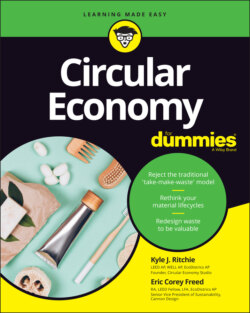Читать книгу Circular Economy For Dummies - Eric Corey Freed - Страница 5
List of Illustrations
Оглавление1 Chapter 2FIGURE 2-1: The typical approach to making clothing is the linear model.FIGURE 2-2: Having one fewer child, which saves 65 tons of carbon emissions per...FIGURE 2-3: If you compare population growth to carbon emissions, you see a dir...
2 Chapter 4FIGURE 4-1: Determining external costs.FIGURE 4-2: Strengths, weaknesses, opportunities, and threats.
3 Chapter 5FIGURE 5-1: The ReSOLVE circular framework, highlighting the circular economy's...
4 Chapter 6FIGURE 6-1: A product has two prices: the retail price you pay and the hidden p...
5 Chapter 7FIGURE 7-1: Companies spend a lot of money on R&D.FIGURE 7-2: The five steps to crafting a circular business model.FIGURE 7-3: Telling your brand's story.FIGURE 7-4: Making a list and checking it twice.
6 Chapter 10FIGURE 10-1: The Ellen MacArthur Foundation’s Butterfly Diagram.
7 Chapter 11FIGURE 11-1: The Ellen MacArthur Foundation Butterfly Diagram of the circular e...
8 Chapter 12FIGURE 12-1: Comparing a linear versus a circular approach to lifecycle.FIGURE 12-2: Example of how Trader Joe’s shows off its commitment to reduce pla...
9 Chapter 13FIGURE 13-1: Mismanaged plastic waste.FIGURE 13-2: Measuring global plastics production.FIGURE 13-3: Picturing materials waste.FIGURE 13-4: Tracking carbon emissions.
10 Chapter 14FIGURE 14-1: Transitioning from eco-efficiency to eco-effectiveness to create a...FIGURE 14-2: Exploring the relationship between regionality and lifecycle manag...FIGURE 14-3: Comparing local and non-local businesses.FIGURE 14-4: Delivery services can reduce overall vehicle miles.
11 Chapter 15FIGURE 15-1: World population growth since 1700.FIGURE 15-2: The permaculture design principles.FIGURE 15-3: Permaculture management zones.
12 Chapter 16FIGURE 16-1: The linear economy compared to a circular economy — the difference...FIGURE 16-2: Total CO2 emissions by sector: The construction and operation of b...FIGURE 16-3: Not all the various layers of a building have the same expected us...FIGURE 16-4: Simple changes to how you detail your buildings will improve the c...
13 Chapter 17FIGURE 17-1: Carbon dioxide emissions, from 800,000 BCE to the present.FIGURE 17-2: Building types and materials affect carbon dioxide emissions.
14 Chapter 18FIGURE 18-1: Clothing sales are growing, but times worn is declining.FIGURE 18-2: The negative effects of today's clothing “system.”FIGURE 18-3: Future resource consumption in the fashion-and-textile industry.FIGURE 18-4: Transitioning the fashion industry from linear mode to circular.FIGURE 18-5: The major material types in the fashion industry.
15 Chapter 20FIGURE 20-1: A Dutch think tank's circular economy report highlights seven area...
16 Chapter 23FIGURE 23-1: Circularity and the 10 Rs.
